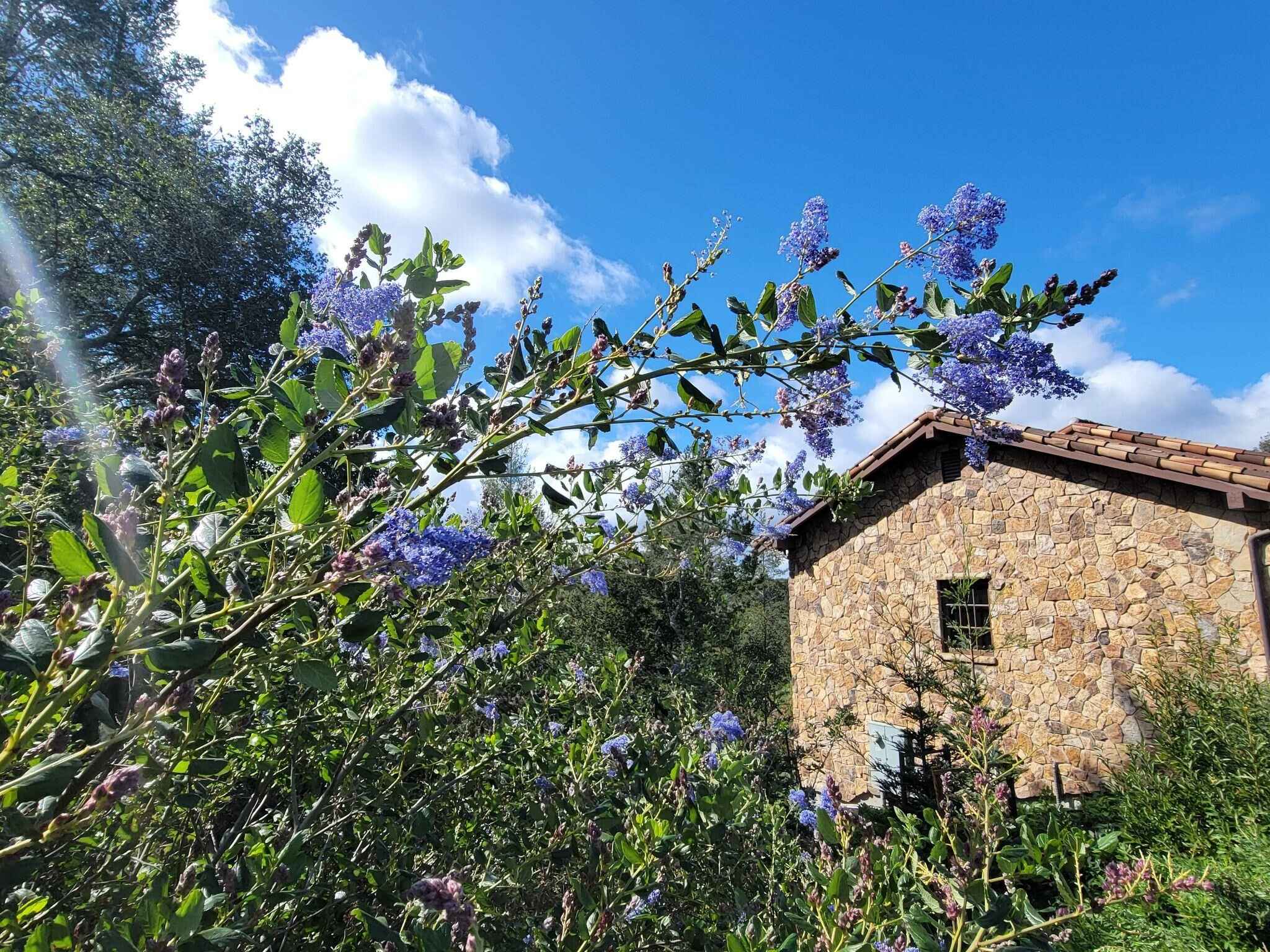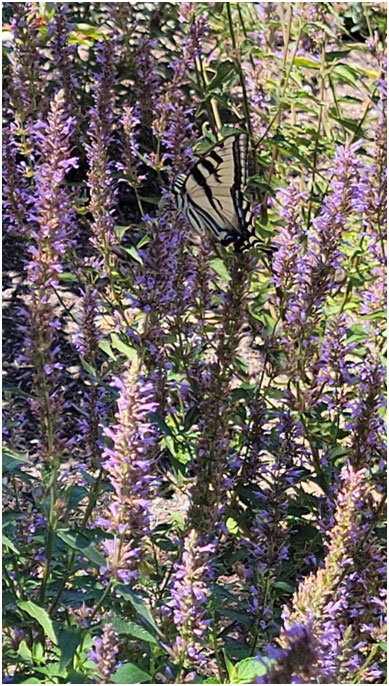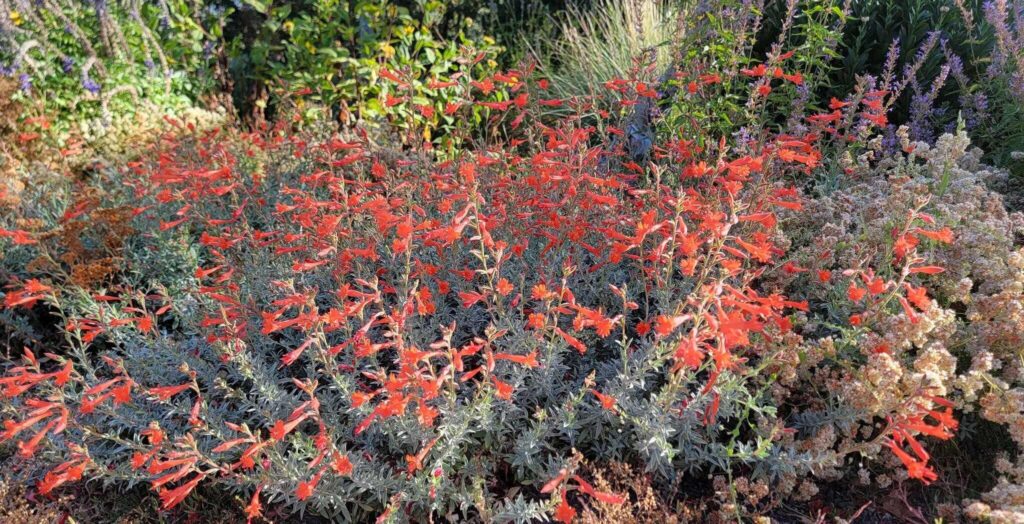
How Can I Attract Butterflies and Hummingbirds to My Garden?
Attracting hummingbirds and butterflies is a hallmark of the Inspired Landscapes design aesthetic. We believe a garden is so much more than the plants, with its value extending into the wildlife who visit it, along with its fragrance, texture, and dynamics of space. As experienced landscaping, garden, and backyard designers near you, with our assistance your garden can become a beautiful ecosystem. Here are the essential tips we regularly use with our clients to ensure their garden is vibrant with the energy of butterflies and hummingbirds.
TLDR: Attracting Butterflies and Hummingbirds
Salvia plant types typically attract both animals. Planting near windows or garden benches helps ensure you’ll be able to enjoy a visit from this wildlife. Aim for a sunny spot!
For specific butterfly or hummingbird types, you can use specific plants to better encourage their appearance in your garden.
What are the Best Plants to Attract Butterflies and Hummingbirds?
 The best plants for attracting butterflies and hummingbirds are ones which provide nectar food sources from their flowers, creating a more eco-friendly garden and ecosystem. Nectar producing flowers tend to have a tubular shape which hummingbirds and butterflies sip from using their long tongues, in a butterflies case it’s tongue is called a proboscis, which can unfurl and nectar sipped through it like a straw. While many types of flowers produce nectar, these tubular flowers are often inaccessible as food sources to other pollinator species who don’t possess a long tongue able to reach deep into its nectar reserves.
The best plants for attracting butterflies and hummingbirds are ones which provide nectar food sources from their flowers, creating a more eco-friendly garden and ecosystem. Nectar producing flowers tend to have a tubular shape which hummingbirds and butterflies sip from using their long tongues, in a butterflies case it’s tongue is called a proboscis, which can unfurl and nectar sipped through it like a straw. While many types of flowers produce nectar, these tubular flowers are often inaccessible as food sources to other pollinator species who don’t possess a long tongue able to reach deep into its nectar reserves.
What Perennials Should I Plant to Attract Butterflies?
Choosing the right perennials can transform your garden into a vibrant haven for butterflies, providing them with essential nectar sources and a welcoming habitat throughout the seasons. Consider how to attract the following native butterfly species:
Tiger Swallowtail
Tiger Swallowtail butterflies adore Agastache ‘Purple haze’ and Verbena bonariensis ‘Purpletop Vervain’ for their abundant clusters of purple nectar rich flowers which bloom for the vast majority of warm months in Sonoma County. We consider both essential choices for any Sonoma County butterfly garden.
Monarch Butterflies
Attracting Monarch butterflies is best done using our native Milkweeds which are Asclepias fascicularis ‘Narrow Leaf Milkweed’ and Asclepias speciosa ‘Showy Milkweed’. Both perform wonderfully in Sonoma County landscapes and thrive with little to no water once established. They serve as nectar sources but more importantly are the plant which Monarch caterpillars feed upon before they pupate and hatch. Having a cluster or two of native Milkweed can get your garden ready for spring and be a perfect way to ensure Monarchs make a seasonal home in your garden.
Pipevine Swallowtail
Pipevine Swallowtail, perhaps the most beautiful of all native butterflies, solely feeds upon Aristolchia californica ‘Dutchman’s Pipevine’ and therefore it is a critical habitat to include in your garden. With its incredible iridescent blue wings spotted with bright orange, it’s a wonder to witness it floating about. The black caterpillars with orange spots are hard to miss and quite exotic as well, and they can nearly cover Pipevine plants when active. The Pipevine itself is also quite exotic in appearance with its vase-like pitcher flowers reminiscent of carnivorous plants which as associate with tropical climates.
Attracting All Stages of Butterfly
It’s important to consider planting a balance between food sources for mature butterflies and caterpillars, as many of the most beautiful local butterflies only feed on very specific plants such as the Monarch and Pipevine Swallowtail listed above.
What Attracts Hummingbirds the Most?

Hummingbirds are easily excited by many of our Sonoma County native plants such as Epilobium canum ‘California Fuscia’ and Salvia spathacea ‘Hummingbird Sage’. Both have long tubular flowers which are highly attractive to hummingbirds, and they can be found in mass around the prolific blooms produced by both plants. Our native ‘Anna’s Hummingbird’ as well as many others will readily visit your garden to take sips from their flowers, and when planted in large groups they become irresistible sanctuaries for these lovely birds. Not enough time? Consider hiring a landscape designer like Inspired Landscapes to get your garden ready for wildlife!
Epilobium Canum
Epilobium canum is an incredible landscape plant for Sonoma County and readily thrives in many types of conditions including rich well irrigated soils, as well as dry gardens, and is often found jutting from rock outcroppings in seemingly impossible growing conditions when found in the wild. Some of our favorite cultivars include Scheiffelin’s choice for its dramatic silver foliage with contrasting deep red flowers, ‘Everett’s Choice’ for is low and rapidly spreading habits, and ‘Catalina’ as a background plant interspersed with ornamental grasses as it grows quite tall, sometimes with blooms over 5’ in height. There truly is an Epilobium for every occasion.
Saliva Spathacea
Salvia spathacea ‘Hummingbird Sage’, says it all in its name, as a spreading ground cover that loves part sun or even shade conditions, it’s a wonderful option for those with less intense sun conditions in their gardens. We incorporate it into our designs on the fringes of Oak Canopies or among the dappled shade of larger Manzanitas or below decorative trees. Hummingbird Sage will thrive in Sonoma County without irrigation once established however it does prefer an occasional summer watering to remain looking it’s best.
Where is the Best Place to Plant Hummingbird Plants?
The best place for hummingbird plants is up close to windows, or garden benches so that you can enjoy their presence up close. A sunny spot that encourages large and long-lasting blooms is ideal as most nectar plants enjoy full sun conditions.
Break Time
Placing them nearby more robust shrubs such as Manzanita help provide resting places for the birds between sips of nectar as they expend a ton of energy flying around, they are more attracted to gardens with small perches readily available. With help from professional backyard designers near you, your garden can bloom beautifully with plants for every season!
Water Features
Additionally providing a place for them to bathe with a bird bath or other pool of water dramatically increases the attractiveness of your garden for hummingbirds and butterflies alike.
What are the Best Plants for Hummingbirds and Butterflies in Sonoma County?
Creating a garden that attracts both hummingbirds and butterflies in Sonoma County requires selecting plants that thrive in the region’s climate while providing ample nectar and shelter for these pollinators:
Salvia Plant Types
Salvia is one of the best plant types for both hummingbirds and butterflies, ‘Mystic Spires Blue’, ‘Black and Blue’, and native cleavlandii, sonomensis or leucophylla types such as ‘Pozo Blue’, ‘Ms. Beard’, ‘Allen Chickering’, and ‘Winnifed Gilman’ are all superb choices.
Echinacea Purpurea
Echinacea purpurea is also a wonderful choice, we prefer to use the straight species type of Echinacea as it is far more attractive to pollinators. However, cultivars such as ‘Magnus’, ‘White King’, and ‘Sombrero’ all perform wonderfully and attract butterflies in large numbers.
Erigonum Fasciculatum
Eriogonum fasciculatum can’t go without mention, as it is perhaps the most important plant in ecological terms for local pollinators of all types. It’s a must-have as a border plant for food producing gardens as it dramatically increases pollination and pest control with the wide variety of insects it attracts, helping to transform your outdoor space. Smaller native butterflies of all types enthusiastically flutter about the profuse blooms which cover it in mid-late summer.
Ceanothus
Lastly, native Ceanothus is a wonderful late-winter and early spring bloomer that provides essential food sources when most other flowering plants are dormant. Coming in a wide range of shapes and sizes, from ground covers such as ‘Anchor Bay’, and ‘Yankee Point’ to the large shrubs ‘Dark Star’, and ‘Ray Hartman’, there is a Ceanothus for every occasion.
Craft Your Garden Paradise – Inspired Landscapes
At Inspired Landscapes, we specialize in creating dynamic, ecologically rich gardens that not only look stunning but also support local wildlife. If you’re ready to turn your outdoor space into a sanctuary for pollinators, our team of expert landscape designers is here to help. Contact Inspired Landscapes today or give us a call at (707) 395-7474 to schedule a consultation and bring the beauty of nature right to your doorstep!

Owner, Inspired Landscapes LLC
Matthew Ripley is the owner of Inspired Landscapes LLC, a Healdsburg based landscape design, installation, maintenance, and irrigation firm serving Sonoma County. His work blends horticultural expertise with sustainable practices, drawing creative influence from Sierra backpacking and Sonoma winery estates to craft gardens that invite wildlife and year round color. Client testimonials highlight his design leadership on residential, estate, and winery properties across the region.





